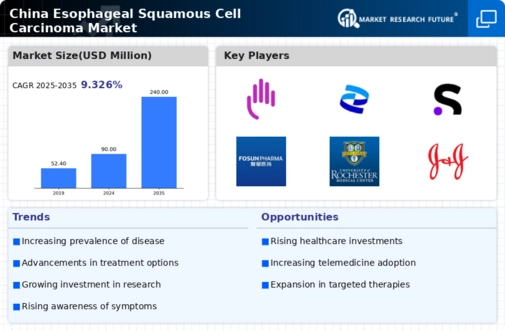Growing Aging Population
China's demographic shift towards an aging population significantly impacts the esophageal squamous-cell-carcinoma market. With over 250 million individuals aged 60 and above, the prevalence of age-related diseases, including esophageal cancer, is on the rise. Older adults are more susceptible to various cancers due to factors such as weakened immune systems and prolonged exposure to risk factors like smoking and dietary habits. This demographic trend suggests a potential increase in the incidence of esophageal squamous-cell-carcinoma, thereby driving demand for effective treatment options. The market is expected to expand as healthcare providers focus on developing tailored therapies for this age group, addressing their unique needs and improving survival rates. As a result, the esophageal squamous-cell-carcinoma market is poised for growth in response to the challenges posed by an aging population.
Increasing Healthcare Expenditure
The rising healthcare expenditure in China is a crucial driver for the esophageal squamous-cell-carcinoma market. As the government allocates more funds towards healthcare, there is a notable increase in the availability of advanced diagnostic and treatment options for patients. In 2023, healthcare spending in China reached approximately $1.2 trillion, reflecting a growth rate of around 10% annually. This financial commitment enables hospitals and clinics to invest in cutting-edge technologies and therapies, thereby enhancing patient outcomes. Furthermore, increased funding supports research initiatives aimed at understanding the disease better, which could lead to innovative treatment solutions. Consequently, the esophageal squamous-cell-carcinoma market is likely to benefit from this trend, as more resources become available for patient care and research.
Rising Awareness and Screening Programs
The increasing awareness of esophageal squamous-cell-carcinoma among the Chinese population is a significant driver for the market. Public health campaigns and educational initiatives are effectively informing individuals about the risk factors and symptoms associated with this type of cancer. As awareness grows, more people are likely to seek medical attention, leading to earlier diagnosis and treatment. Furthermore, the implementation of screening programs in high-risk populations is becoming more prevalent, which could enhance early detection rates. In 2023, it was estimated that screening initiatives could potentially increase early diagnosis by up to 30%. This proactive approach not only improves patient outcomes but also drives demand for treatment options within the esophageal squamous-cell-carcinoma market.
Government Support and Policy Initiatives
Government support and policy initiatives play a pivotal role in shaping the esophageal squamous-cell-carcinoma market in China. The Chinese government has introduced various policies aimed at improving cancer care and treatment accessibility. Initiatives such as the Healthy China 2030 plan emphasize the importance of cancer prevention, early detection, and treatment. Additionally, subsidies for cancer medications and support for clinical trials are enhancing the landscape for patients and healthcare providers. In 2023, the government allocated approximately $500 million towards cancer research and treatment programs, which is expected to bolster the esophageal squamous-cell-carcinoma market. This supportive environment encourages innovation and ensures that patients have access to necessary therapies, ultimately contributing to market growth.
Enhanced Research and Development Initiatives
The esophageal squamous-cell-carcinoma market is experiencing a surge in research and development initiatives, which is a vital driver for its growth. Chinese pharmaceutical companies and research institutions are increasingly investing in the development of novel therapies and treatment protocols. In 2023, R&D spending in the oncology sector reached approximately $15 billion, with a significant portion allocated to esophageal cancer research. This investment is likely to yield innovative treatment options, including targeted therapies and immunotherapies, which could improve patient outcomes. Additionally, collaborations between academic institutions and industry players are fostering a conducive environment for breakthroughs in understanding the disease. As a result, the esophageal squamous-cell-carcinoma market is expected to benefit from these advancements, leading to improved treatment modalities and increased patient access to cutting-edge therapies.

















Leave a Comment